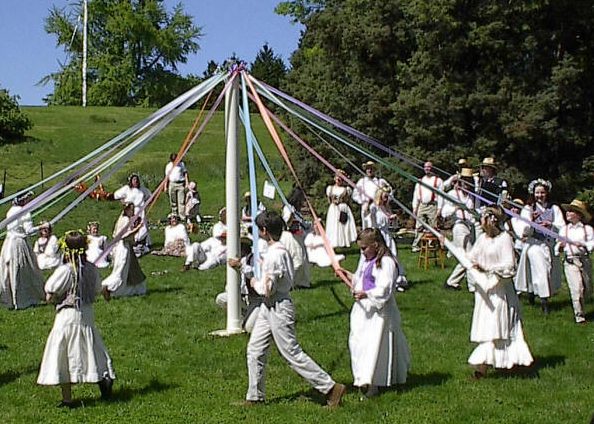
Beltaine and Arbor Day: Celebration of Earth in bloom
By Cris McCullough
Beltaine. May Day. Many of us associate mid-spring with the quaint traditions of dancing around a May Pole or the crowning of the May Queen. This is a time of exchange with nature, a time to celebrate renewal in all its forms. Buds begin to form on the trees, encouraging us to slow down and pay attention. Celebrating Beltaine and trees is an ancient tradition, one that translates contemporarily to a sweet stop in the woods. Anyone who has placed a hand on a tree to intuitively “listen” to the sap beginning to flow can agree.
Even exchange: Celebrating Beltaine and trees
Beltaine is an ancient Celtic festival of renewal and fertility dating from Roman times. Entire villages would gather and sleep under the stars, celebrating Beltaine and trees. Couples, seeking permission to be together, jumped the bonfire as a sign of promise, declaring their intentions for the coming year.
There was always an exchange with nature. Our ancestors knew that we must give in order to receive; therefore, there always was the offer of an animal or human sacrifice. In her book Celtic Inspirations, Lyn Webster Wilde notes that the rite of sacrifice has shifted to the sharing of a communal Bannock Cake baked on the Beltaine fire. Pieces were shared among the celebrants. Whoever got the burned piece was declared “sacrifice” and had to jump the fire.
Our ancestors knew instinctively that all of nature was alive. They believed if we conserved and honored our surroundings, nature would take care of our needs. It was an even exchange. The concept feels lost in our modern mentality of “take.” However, listening and responding to our natural environment in a mindful way is now more important than ever.
Trees provide the root of all healing
Established in 1872, Arbor Day is usually celebrated on the last week of April. In 1972, The Arbor Day Foundation was formed, inspiring people to plant, nurture, and celebrate trees year round. That simple mission has had a global impact. Trees are a proven, affordable, natural way to pull carbon dioxide from the atmosphere. Plantings can be implemented quickly and efficiently.
There are many ways to collaborate with trees, and their ecosystems, furthering their benefit worldwide, as well as within the microcosm of the human body. Partner with Nature offers simple and sustainable ways that go beyond connection and understanding of nature. They believe everyone can collaborate with nature as partners. Simple concepts such as healing and meditation can heal not only the individual, but also the ecosystem as a whole. Learn more in less than ten minutes with these videos and tips for collaborating with nature.
Planting trees: Honor community and the environment
As noted by The Arbor Day Foundation, trees play a critical role in creating healthier, safer, and more connected communities. They clean the air, filter our water, and even slow storm surge and flooding in cities. Trees also provide shade and cool cities by up to 10 degrees. This has been found to help prevent heat-related deaths in urban areas.
Even as social and economic issues fracture society, trees continue to connect communities, cultures, and generations. According to Arbor Day’s website, having neighborhood trees has been shown to reduce stress, improve overall health and development in children, and encourage physical activity. And a healthy community-wide tree canopy fosters economic advantages as well as an increase in civic pride among residents.
This Arbor Day, take the time to appreciate all that nature does for us. In celebration of its 150th anniversary, the Foundation suggests 150 ways you can connect, celebrate and honor your environment. Go to The Arbor Day Foundation Website to discover 150 Ways to Celebrate Trees. Or visit Partner with Nature to get access to more free tips, meditations, talks and advice for partnering with nature while celebrating Beltaine and trees, or anytime of year!
Mind Key and The Daily Key are registered Amazon Associates. We may earn a commission from qualifying Amazon.com purchases linked to in this article.



 Community maypole in RI Cris McCullough
Community maypole in RI Cris McCullough  Community maypole in RI Cris McCullough
Community maypole in RI Cris McCullough